Post from Guest Blogger – Was this an inspiration for Angkorvat ?
After completing 100 posts, I wanted a breath of fresh air in my blog. And I thought I should have a guest blogger, someone whom I recently met and who has been an inspiration for me when I go on my trails. I frequently chew his head for information and he patiently narrates snippets of South Indian history. I have learnt to appreciate Indian sculptures better and understand the nuances of Indian art as well. VJ is a shipping professional from Madras (Chennai) and I met him through another friend Siva. VJ is currently based in Singapore and has a keen interest in Indian sculptures . By his own admission, he learns something new every 6 months and its not just in arts . Sports – golf, cricket,soccer,hockey, shot put, shuttle..is his other interest. In arts, he has learnt calligraphy,Tanjore painting, glass painting,oil painting, sketching and cartooning,wood carving and pyrography.He has even designed furniture with old tea bushes. Do read his blog www.poetryinstone.in, which is a veritable treasure house of knowledge and here is a gem from there .Over to VJ..
At the outset my thanks to Lakshmi for asking me write this blog in her site as a guest. After dabbling in many subjects, I finally found my hearts fill in sculpture. The call of this dying art is unique -these images are dormant yet speak volumes, and like learning a new language once your learn their tongue, its sheer poetry in stone.
Since this site is about backpacking and travel, thought I would mix a bit of both in this post – so I introduce you to a little known monument – Masroor.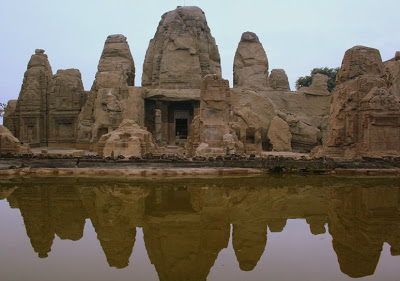
Call it serendipity, but i was looking for a good picture of the Mahabalipuram test panel when i came across a familiar face – a real stud who turned out to be my buddy from preschool. We chatted up and promptly in a couple weeks he sent me some pictures of his visit to Himachal Pradesh, to a hither too unheard of place (at least to me) called Masroor.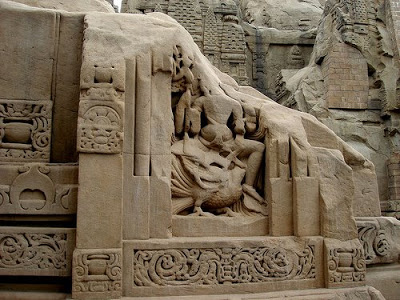
What I saw blew me away. The Masroor temple complex is in Himachal Pradesh ( near Kangra – 20kms and Dharamsala – 45 kms. At a distance the sandstone hill doesn’t quite give up it secrets – a late 8th Century rock cut Shiva temple. Hailing from Chennai Rock cut shrines and caves are my particular favorites, not just for their artistic skill but also for their complexity ( need to carved in situ on live rock – top down) – they are many superb examples of this in South India and western India but had not expected something of this scale,size and most importantly the style. 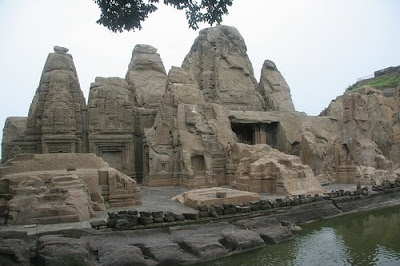
I am sure all of you have heardof Angkorwat – a 11th Century Cambodian temple complex. What interested me with Masroor is the uncanny resemblance /similarity between these two – complete with the tank in front – beautifully mirroring the structure on top.
http://news.nationalgeographic.com/news/2007/08/photogalleries/Angkor-pictures/
The relief carvings are amazingly detailed but have borne the brunt of nature, yet my imagination runs wild when I think of how these beauties would have looked when they were sculpted or does the aging adding to their beauty. Angkor got its fame from the overgrowth of vegetation and Angelina Jolie/ Lara Croft, maybe Masroor needs
Priyanka Chopra to do a similar one to gain recognition.
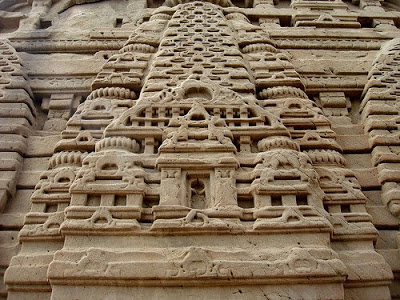
Could this have been the inspiration behind Angkor ?

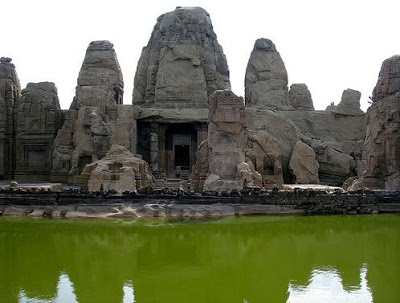
wow! what a link….;)
simply wonderful.
But i have a question. VJ, is the type of rock in the Masroor area similar to that in the Mahbalipuram area ? Is it similar to the soil in Angkor Wat ? One tends to think about how populations could have migrated back then, how they could have travelled so far , and so on.
Lakshmi, thank you for thinking of putting this on your blog.
Hi Ugich ( hope i got it right)
Masroor is sandstone while Mallai is granite. That why carving mallai would be a greater feat. In terms of stone sculpture, pallavas are beyond compare – you can view here
http://www.poetryinstone.in/2008/09/05/divinely-inspired/en/
Angkor was predominantly hindu civilisation ( vishnu worshipers) – The main complex was the effort of cambodian king Suryavarman. There have been many instances dating back to pallavas of interaction with south east asia – ( pandyas have references to middle east dating from 4th C BC) infact they had marital arrangements with each other – so much so that once when the pallava throne fell vacant due to lack of heirs, a prince from Cambodia is said to have been brought to continue the line.
Rajendra chola launched a naval assault on the Srivijayan kingdom and laid to waste a multitude of ports – stretching from malaysia to palembang / java.
There are tons of tamil inscriptions all over south east asia – infact there is a 7th C tamil inscription in Jakarta ( grant for constructing a canal in record time)
rgds
vj
Mind blowing… awesome.. i liked the first pic. U r doing a great job with this…i hv HP in my radar I will surely keep it is mind..
Bonjour !
Elles sont SUBERBES ces vieilles pierres.
Ta région cache des trésors…
Buddy u have an award waiting in my blog, pls do check 🙂
Lovely pictures!Great job done VJ 🙂
Fascinating..recently for a project i was working on, i did some research on Angkor Wat, and dug up pics….
This is awesome…. looking fwd to reading more about Masroor and just mite visit!!!
I don’t really believe in magical numbers as 100th post.
Interesting parallel..possible
the last shot is lovely…
your blog relaxed me today after knowing the delhi blasts..
hmmm maybe….the khmer empire did have a strong hindu/indian influence….
good food for though..
I have passed through this area few times and never heard of Masroor. I dont think its yet on tourist/traveler circuit. HP other wise is doing good in terms of marketing their worthy places.
I would pass on the link to couple of folks who belong to HP, write blogs and probably can pass the word around. Thanks for sharing VJ.
Nandan
This is truely amazing. And the super-structure does resemble the Angkor Vat temples. There is so many of history in ruins in India that is untended that no one quite knows where to find them. Congratulations on your 100th post!
Wonderful! Never thought that such a temple would exist in India and maybe there are more! This one does look very similar to the Cambodian one 🙂
Wow thats one amazing temple, and some amazing shots! good job. Keep the posts coming 🙂 I found a site that you might like, its called baraaza.com
So check it out, and keep the good posts comin!
Hi
I am yet to get more information on the Dynasty that is credited with masroor, but understand the similarities between Angkor and Masroor are currently being researched by a team from Univ of Pennsylvania. If i can get more information, i will share with you.
Meantime, on the relations with Pallavas and cambodia – there was an interesting article which came out in the Hindu, some time back –
http://www.hindu.com/yw/2007/03/16/stories/2007031600500200.htm
rgds
vj
Actually, Angkor Wat has a large central spire surrounded by four smaller spires, to symbolise the Mount Meru. In most pictures of Angkor Wat, you can only see three spires, the large central one and the two smaller spires in the forefront.
In Masroor, the temple spires look side by side. So the similarity is a product of the angles in which the photographs are taken. Also in Angkor Wat, the water-filled moat completely surrounds the temple complex, corresponding to the Hindu cosmological worldview.
It must be said that the Angkor empire was very predominantly Hindu until the 14th and 15th centuries before Theravada Buddhism became the dominant religion. Also, the temple complex of Masroor is much, much older than Angkor Wat – preceding it by five centuries.
Yeah, the silhouette of Masroor really looks like Angkor Wat at one glance, though the surface of the architecture seems to be more corroded?
I learnt something today. Thanks! 😀
I’m sure there’s a connection.
Hi,
You can read this post on how much Hindu literature inspired cambodian art.
http://www.poetryinstone.in/?s=shakes
The tamil version is more detailed, sadly can’t bring the beauty of the tamil verse into the english version fully, but tamil readers can see the beauty of the verse being translated into stone in far off Cambodia – there are even more lovely works there incl a delightful version showing Karaikkal Ammai which i will post in my site shortly.
rgds
vj
Ah !!! these are real beauty and natural scent …
i sometime envy you Lakshmi…u visit so many places around globe 😛
nevertheless splendid shots
Beautiful pictures! I have never heard of this place. Great guy, your fiend. 🙂
Thanks for sharing Masroor. It beautiful and seems so calm. Is it part of the India heritage sites., because I see a few areas that definitely need to be preserved!
nice pics….and this is soo close to Dharmashala..where i went not to far back..could have gone there if i knew about it before…
Wow 1 Never heard of this or seen pictures. Thanks for sharing info .
First..congrats Lakshmi on 100 posts! AND thank you for this guest blogger piece.
so interesting and beautiful, your country is astounding!
Awesome !!
Dear Lakshmi and VJ,
Thanks for this wonderful post. I have been to HP thrice, but have never heard or seen something of such magnanimity.
Thanks for bringing to light this wonder! 🙂
A quick question – is this being maintained as a heritage site? or is anything being done to maintain and protect Masroor?
I wonder too this could be an inspiration for Angkor!
Thanks akshmi and thank you for a very interesting post VJ.
I had heard of the theory that the Angor Wat’s Khmer architecture may have been influenced by the architecture of Tamil Nadu. There is also a theory that it was based on the representation of Mt. Meru. Now we know, thanks to this lovely post, that it may have been inspired by the beauty of the temple of Masroor.
I wonder which was built first.
Hi,
Masroor predates Angkor by 300 years ( had mentioned inside the post)
Regarding Mt Meru, The Tanjore Big temple vimanam is probably the grandest representation of Maha Meru. You can see my post and the massiveness of the whole complex here
http://www.poetryinstone.in/lang/en/2008/09/14/how-big-is-big-part-2-on-the-tanjore-temple
rgds
vj
This is an awesome post – I love these types of interesting information – I would certainly love to visit masroor and see the imposing temple!
love the 1st and the 3rd pic…. 🙂
kudos!
Great blog!!
My experience of the trip to the sate of Himachal is available in http://travelinfoline.blogspot.com/
Check and share feedback
Anuj
Mahabalipuram is a treasure house of ancient Tamil art, culture, civilization, & history. A coastal city, Mahabalipuram has an immense place of importance in Tamil history and mythology. This beautiful coastal city of Tamil Nadu is ordained with a number of temples and places of archeological importance. It is not surprising therefore, that because of the overabundance of these places Mahabalipuram is often referred to as a legacy in stone. The unique instances of art, culture and architecture that has been preserved by the kings of the then Pallava dynasty proves to be a delight to the eye even today and it is not for nothing that Mahabalipuram is known as an “open air museum”. The richness of Mahabalipuram has made it one of the most favorite tourist places of South India. Hotels in Mahabalipuram are for tourists from different walks of life. As the place is more of a tourist destination rather than a business one, there are many leisure hotels and budget hotels in Mahabalipuram.
mind blowing , superb, splendid , matchless and fascinating ! Great job Vijay babu ! Write more on this matter!
Great pictures. Similar experience visiting Varanasi.
Other cities with beautiful temples is Konark in Orissa
Enchanting